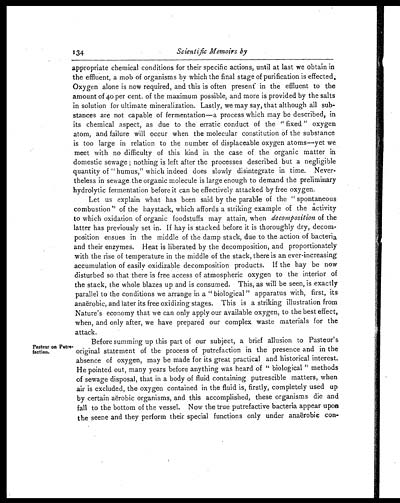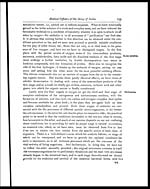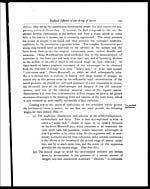Medicine - Institutions > Army health reports and medical documents > Scientific memoirs by medical officers of the Army of India > Part XII, 1901 > 6 - On some practical methods of sanitation in India with special reference to cantonments
(178) Page 134
Download files
Individual page:
Thumbnail gallery: Grid view | List view

134
Scientific Memoirs by
appropriate chemical conditions for their specific actions, until at last we obtain in
the effluent, a mob of organisms by which the final stage of purification is effected.
Oxygen alone is now required, and this is often present in the effluent to the
amount of 40 per cent. of the maximum possible, and more is provided by the salts
in solution for ultimate mineralization. Lastly, we may say, that although all sub-
stances are not capable of fermentation—a process which may be described, in
its chemical aspect, as due to the erratic conduct of the "fixed" oxygen
atom, and failure will occur when the molecular constitution of the substance
is too large in relation to the number of displaceable oxygen atoms—yet we
meet with no difficulty of this kind in the case of the organic matter in
domestic sewage; nothing is left after the processes described but a negligible
quantity of "humus," which indeed does slowly disintegrate in time. Never-
theless in sewage the organic molecule is large enough to demand the preliminary
hydrolytic fermentation before it can be effectively attacked by free oxygen.
Let us explain what has been said by the parable of the "spontaneous
combustion" of the haystack, which affords a striking example of the activity
to which oxidation of organic foodstuffs may attain, when decomposition of the
latter has previously set in. If hay is stacked before it is thoroughly dry, decom-
position ensues in the middle of the damp stack, due to the action of bacteria
and their enzymes. Heat is liberated by the decomposition, and proportionately
with the rise of temperature in the middle of the stack, there is an ever-increasing
accumulation of easily oxidizable decomposition products. If the hay be now
disturbed so that there is free access of atmospheric oxygen to the interior of
the stack, the whole blazes up and is consumed. This, as will be seen, is exactly
parallel to the conditions we arrange in a "biological" apparatus with, first, its
anaërobic, and later its free oxidizing stages. This is a striking illustration from
Nature's economy that we can only apply our available oxygen, to the best effect,
when, and only after, we have prepared our complex waste materials for the
attack.
Pasteur on Putre-
faction.
Before summing up this part of our subject, a brief allusion to Pasteur's
original statement of the process of putrefaction in the presence and in the
absence of oxygen, may be made for its great practical and historical interest.
He pointed out, many years before anything was heard of "biological" methods
of sewage disposal, that in a body of fluid containing putrescible matters, when
air is excluded, the oxygen contained in the fluid is, firstly, completely used up
by certain aerobic organisms, and this accomplished, these organisms die and
fall to the bottom of the vessel. Now the true putrefactive bacteria appear upon
the seene and they perform their special functions only under anaërobic con-
Set display mode to: Large image | Zoom image | Transcription
Images and transcriptions on this page, including medium image downloads, may be used under the Creative Commons Attribution 4.0 International Licence unless otherwise stated. ![]()
| Permanent URL | https://digital.nls.uk/75005277 |
|---|
| Shelfmark | IP/QB.10 |
|---|---|
| Additional NLS resources: | |




